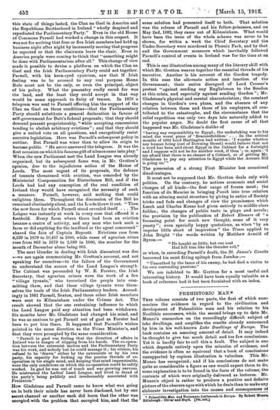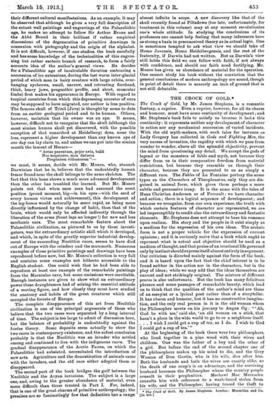PREHISTORIC MAN. 40 .
THIS volume consists of two parts, the first of which sum. marizes the evidence in regard to the civilization and development of Palaeolithic man and his relation to his Neolithic successors, while the second brings up to date Mr. Munro's researches on the exceedingly difficult subject of lake dwellings, and amplifies the results already announced by him in his well-known Lake Dwellings of Europe. The book contains an amazing amount of detail. It may indeed be thought to give too much detail and too few conclusions. Yet it is hardly fair to call this a fault. The subject is one which depends entirely upon the minutia of evidence, and the evidence is often so equivocal that a book of conclusions unsupported by copious illustration is valueless. This Mr. Munro has recognized ; and if his conclusions do not make quite so considerable a figure as one would expect them to do, some explanation is to be found in the form of the volume, the contents of which were originally delivered as lectures. - Mr. Munro's object is rather to produce a positive and definite picture of the obscure ages with which he deals than to make any elaborate investigation into the causes and consequences of
• Palaeolithic Nan and Terramara Estuenzenai ni Europa. By Robert Idunro, Edinburgh : !Nicer and Boyd. (16e. net.]
their different cultural manifestations. As an. example, it may be observed that although he gives a very full description of the extant wall paintings and engravings of the Palaeolithic age, he makes no attempt to follow Sir Arthur Evans and the Abbe Breuil in their brilliant if rather empirical discussions of the degeneration of primitive drawings in connexion with pictography and the origin of the alphabet. It is not difficult, however, if one studios the book carefully and has some knowledge of the technicalities of this engros- sing but rather esoteric branch of research, to form a fairly accurate idea of the author's general views. He decides for a Palaeolithic age of incalculable duration embracing a succession of ice extensions, during the last warm inter-glacial
period of which man (a hairy creature with large orbits, over- hanging eyebrows, small, narrow, and retreating forehead, thick, heavy jaws, prognathic profile, and short, muscular limbs) first makes his appearance in Europe. "With regard to tropical countries from which this depressing ancestor of ours may be supposed to have migrated, our author is less positive. The famous skull of Trinil (Java) is thought by some to date from an earlier geological period and to be human. Others, however, maintain that its owner was an ape. It seems, however, difficult not to recognize that the skull (although the most simian human skull yet discovered, with the possible exception of that unearthed at Heidelberg) does, none the less, represent a higher development than any known ape of our day can lay claim to, and unless we can put into the simian
mouth the lament of Horace-
" Aetas parentum, pejor avis, tulit Nos nequioreo, mox daturos
Progeniem vitiosiorem "-
we must, it seems, decide with Mr. Munro, who, staunch Darwinian that he is, believes that the undoubtedly human
femur found near the skull belongs to the same skeleton. The fact that this bone shows a much more advanced development than the other has troubled the learned. But Mr. Munro Points out that when once man had assumed the erect position (proud moment, big—in his eyes—with the seed of every human virtue and achievement), this development of the leg-bones would naturally be more rapid, as being more directly influenced by the change of habit, than that of the brain, which would only be affected indirectly through the liberation of the arms (front legs no longer !) for new and less mechanic uses. The most remarkable feature about the Palaeolithic civilization, as pictured to us by these investi- gators, was the extraordinary artistic skill which it developed, and which, in spite of the greatly superior industrial develop- ment of the succeeding Neolithic races, seems to have died out of Europe with the reindeer and the mammoth. Numerous examples of these primitive paintings and drawings have been reproduced before now, but Mr. Munro's collection is very full and contains some examples not hitherto accessible to the English student. One could wish that he had been able to reproduce at least one example of the remarkable paintings from the Marsoulas cave, but some omissions were inevitable. Enough instances are given to show what an extraordinary power these draughtsmen had of seizing the essential attitude of a moving figure, and how closely they must have studied the anatomy and habits of the great creatures which still occupied the forests of Europe.
The complete disappearance of this art from Neolithic civilization is one of the principal arguments of those who believe that the two races were separated by a long interval
of time. The subject is too large to admit of discussion here, but the balance of probability is undoubtedly against the hiatus theory. Some deposits seem actually to show the two races in contemporary existence, and the safest conclusion probably is that the Neolithic was an invader who settled among and continued to live with the indigenous races. The gradual disappearance of the Arctic Fauna, on which the Palaeolithic had subsisted, necessitated the introduction of new arts. Agriculture and the domestication of animals came with the invaders, and the old race either adopted them or
disappeared. The second part of the book bridges the gulf between the Neolithic and the Aryan invasions. The subject is a large one, and owing to the greater abundance of material, even more difficult than those treated in Part I. For, indeed, that is one of the great charms of primitive anthropology; the premises are so fascinatingly few that deducticM has a range almost infinite in scope. A new discovery like that of the skull recently found at Piltsdown (too late, unfortunately, for treatment in this volume) may at any moment revolutionize one's whole attitude. In studying the conclusions of its professors one cannot help feeling that many inferences have as strong a basis in preconceived theory as in actual logic. One is sometimes tempted to ask what view we should take of Homo Javensis, Homo Heidelbergensis, and the rest of the fraternity, if Darwin had not written. But as Darwin's view still holds this field we can follow with faith, if not always with confidence, and should our faith need fortifying, Mr. Munro has given us abundance of material for the operation. One cannot study his book without the conviction that the general conclusions of modern anthropology are sound, though in point of detail there is scarcely an inch of ground that is not still debatable.















































 Previous page
Previous page